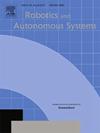Tendon-driven based extensible soft robot with variable stiffness
IF 4.3
2区 计算机科学
Q1 AUTOMATION & CONTROL SYSTEMS
引用次数: 0
Abstract
Extensible soft continuum robots have ubiquitous adoption in confined and intricate environments, owing to their dexterity, wide workspace, and adaptable stiffness. However, their existing designs still encounter challenges such as bulky, limited bending angles, complex modeling and control, and low payload capacity. This article presents a compact design of extensible single-section soft robot-based tendon-driven actuation, consisting of three segments based on a semi-octagon honeycomb pattern. This design is fabricated by varying the soft structure to provide extensibility and variable stiffness by controlling tension and retraction of cables. It consists of three segments; the middle segment, resembling a flexible spring, is sandwiched between two identical segments. A shape estimation using Inertial Measurement Unit (IMU) and motors’ encoders combined with a Constant Curvature assumption, is developed. The design performance is experimentally evaluated by performing workspace reachability, repeatability, payload capability. Additionally, the variable stiffness is verified against external payloads. Furthermore, a design enhancement is carried out to overcome buckling at specific configurations, incorporating flexible hollow hoses embedded within the prototype’s structure. The results verify that the prototype could achieve extension and compression up to 30% and 65% relative to its lengths respectively, high payload capacity reaches 565 gm, and efficient stiffness variation. Moreover, using hollow tubes enhance the payload capability of the robot without significant effect on its original structure.

基于肌腱驱动的可变刚度可扩展软机器人
可扩展软连续体机器人由于其灵巧性、工作空间宽、刚度适应性强等优点,在复杂环境中得到了广泛的应用。然而,他们现有的设计仍然面临着诸如体积庞大、弯曲角度有限、建模和控制复杂以及有效载荷能力低等挑战。本文提出了一种基于半八边形蜂窝结构的可扩展单节软机器人肌腱驱动驱动机构的紧凑设计。这种设计是通过改变软结构来实现的,通过控制电缆的张力和收缩来提供可扩展性和可变刚度。它由三个部分组成;中间部分,类似于一个灵活的弹簧,夹在两个相同的部分之间。提出了一种基于惯性测量单元(IMU)和电机编码器的形状估计方法,并结合恒曲率假设。通过工作空间可达性、可重复性和有效载荷能力对设计性能进行了实验评估。此外,还对外部有效载荷进行了变刚度验证。此外,在设计上进行了改进,以克服特定配置下的屈曲,在原型结构中嵌入了柔性空心软管。结果表明,该原型机可实现相对于其长度的30%和65%的拉伸和压缩,有效载荷达到565 gm,并且具有有效的刚度变化。此外,在不影响机器人原有结构的前提下,采用空心管增强了机器人的有效载荷能力。
本文章由计算机程序翻译,如有差异,请以英文原文为准。
求助全文
约1分钟内获得全文
求助全文
来源期刊

Robotics and Autonomous Systems
工程技术-机器人学
CiteScore
9.00
自引率
7.00%
发文量
164
审稿时长
4.5 months
期刊介绍:
Robotics and Autonomous Systems will carry articles describing fundamental developments in the field of robotics, with special emphasis on autonomous systems. An important goal of this journal is to extend the state of the art in both symbolic and sensory based robot control and learning in the context of autonomous systems.
Robotics and Autonomous Systems will carry articles on the theoretical, computational and experimental aspects of autonomous systems, or modules of such systems.
 求助内容:
求助内容: 应助结果提醒方式:
应助结果提醒方式:


